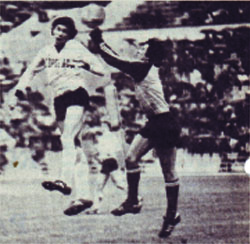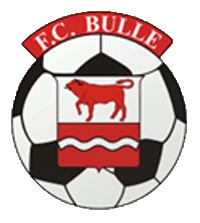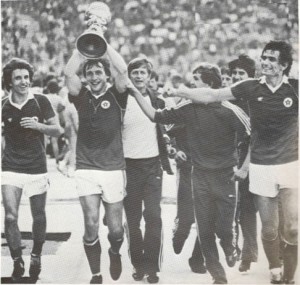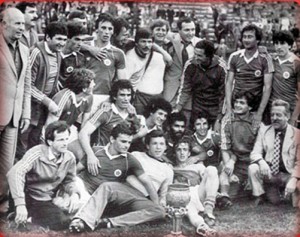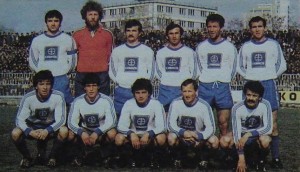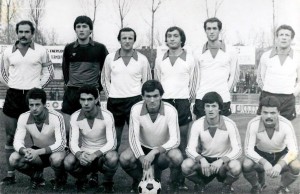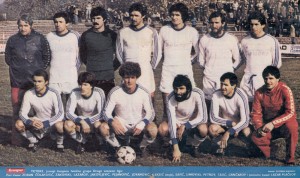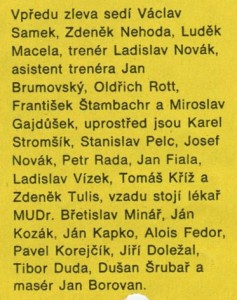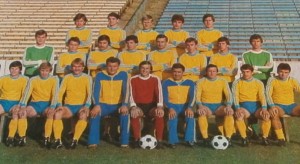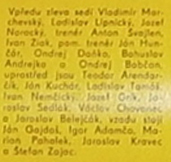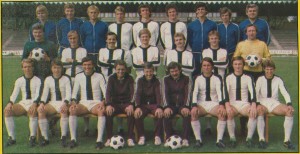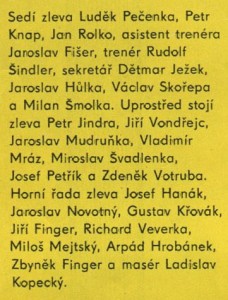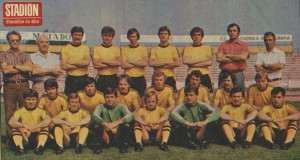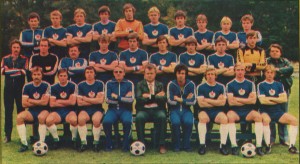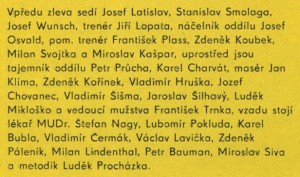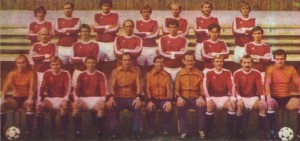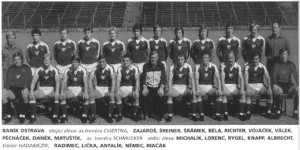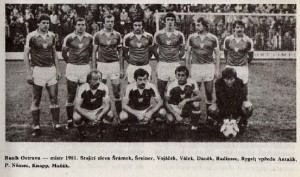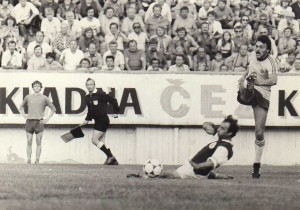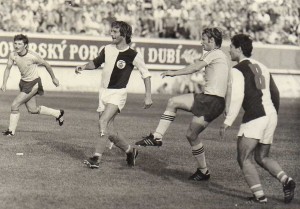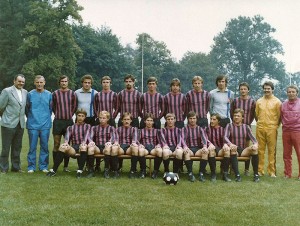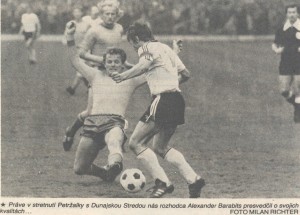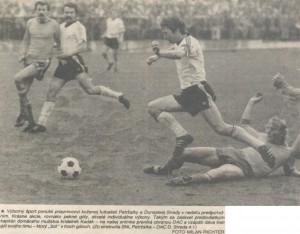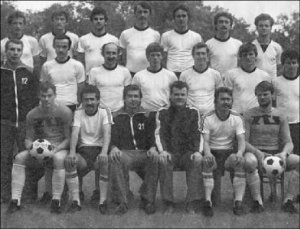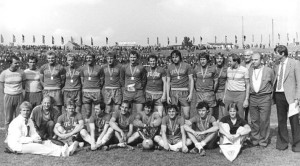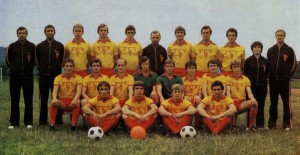The Yugoslavian First Division was a mirror of the second level – to a point. Three teams competed for the title, the other 15 clubs were more or less equal. Seven points divided the 4th from the 17th, but even the very last was not really hopeless – Napredak (Krusevac) finished with 26 points, 3 less than the team just above them.
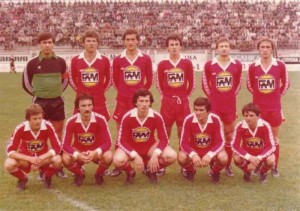 In a fairly equal league small differences decide and Napredak was last just because it was a smaller than most, having slightly weaker players. Not really a surprise their relegation.
In a fairly equal league small differences decide and Napredak was last just because it was a smaller than most, having slightly weaker players. Not really a surprise their relegation.
The second unfortunate was Borac (Banja Luka) – 17th with 29 points and going down. One point more and they would have been safe, but they did not get it.
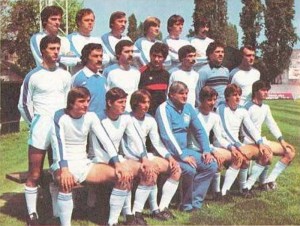 NK Zagreb breathed with relief: they survived by a point. One more first division ahead of them, more or less, the best the club eternally in the shadow of Dinamo (Zagreb) can dream of.
NK Zagreb breathed with relief: they survived by a point. One more first division ahead of them, more or less, the best the club eternally in the shadow of Dinamo (Zagreb) can dream of.
Two clubs were in decline – Vojvodina (Novi Sad) and OFK Beograd (Belgrade).

Gradually, during the 1970s Vojvodina lost its leading position in Yugoslav football. The slump was more pronounced after 1975 and there was no stop – this year they finished 10th. However, they were never in really bad situation – which was not the case of OFK Beograd. They lost their strong position after 1973 and really badly at that – sinking lower and lower, barely surviving this season. They were 15th with 30 points and the way they going made them prime candidates for relegation.
The clubs from Sarajevo did not fair well either, but for different reasons.
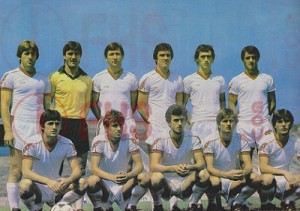 FK Sarajevo finished 13th, but they generally unpredictable up and down club. Zeljeznicar was just behind them – 14th with 32 points, the same as Sarajevo, but with worse goal-difference. However, Zeljeznicar already reached its lowest point, dropping to second division, and now was slowly moving up. So, not bad for the moment – remaining in the top league was the prime goal and it was achieved.
FK Sarajevo finished 13th, but they generally unpredictable up and down club. Zeljeznicar was just behind them – 14th with 32 points, the same as Sarajevo, but with worse goal-difference. However, Zeljeznicar already reached its lowest point, dropping to second division, and now was slowly moving up. So, not bad for the moment – remaining in the top league was the prime goal and it was achieved.
Slightly losing ground was Velez (Mostar) – they were 9th, largely because it was difficult for them to maintain really strong squad, but the club was by no means approaching crisis: they were only slightly weaker compared to the team of the mid-1970s.
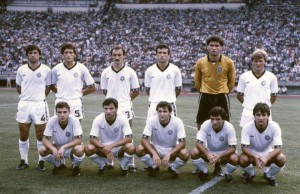 Partizan (Belgrade) had a disastrous season – 8th and only 2 teams won fewer matches than them. The problem, however, was long term – after the end of the 1960s Partizan really lost its leading position. Yes, the aura of the grand derby with Crvena zvezda kept them always under the spotlights, but they were shaky. Compared to arch-rivals, Partizan did not have a great squad for years – they were successful, but only occasionally. And also occasionally they slipped down the table. Decline of some, inconsistency of others others – and good fortune for a third kind of clubs: never really strong, never extraordinary, second- or even third-rate traditionally, now they had a chance to shine partly because of the weakness of usual favourites.
Partizan (Belgrade) had a disastrous season – 8th and only 2 teams won fewer matches than them. The problem, however, was long term – after the end of the 1960s Partizan really lost its leading position. Yes, the aura of the grand derby with Crvena zvezda kept them always under the spotlights, but they were shaky. Compared to arch-rivals, Partizan did not have a great squad for years – they were successful, but only occasionally. And also occasionally they slipped down the table. Decline of some, inconsistency of others others – and good fortune for a third kind of clubs: never really strong, never extraordinary, second- or even third-rate traditionally, now they had a chance to shine partly because of the weakness of usual favourites.
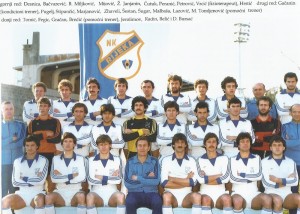 NK Rijeka was 7th, continuing their best period in history. Not an exceptional team, but one the very best they ever had, for the joy of local fans.
NK Rijeka was 7th, continuing their best period in history. Not an exceptional team, but one the very best they ever had, for the joy of local fans.
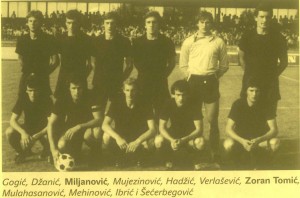 Sloboda (Tuzla) was 4th – traditionally, they were stronger than Rijeka, but hardly the club to be found so high in the table.
Sloboda (Tuzla) was 4th – traditionally, they were stronger than Rijeka, but hardly the club to be found so high in the table.
With a point less than Sloboda, but also with a point more than Buducnost (Titograd), Dinamo (Zagreb) took the 5th place. Not a factor this season, although they had the players for more: Kranjcar, Mlinaric, Ivkovic, to name just a few. Not really at its prime, this squad – or may be they were following the example of Partizan: good teams, but not great and not consistent because of that.
 With that, the bulk of the league ends: Sloboda finished best among similar teams with 36 points. The team above them had 41!
With that, the bulk of the league ends: Sloboda finished best among similar teams with 36 points. The team above them had 41!
The battle for the title went between three clubs, two of them ‘the usual suspects’ and the third surprise intruder, enjoying the best time in its history. Three points separated the favourites at the end. The intruders, may be predictably, finished with fewest points.
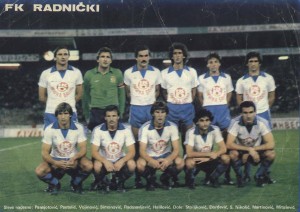
To the delight of their fans, Radnicki (Nis), usually a lowly club, suddenly soared to a title contender. Radnicki finished 3rd the previous year, which was seen as an accident by skeptics, but this time they aimed at the title – and nothing terrible they lost it by 3 points. The team had excellent season in the UEFA Cup at the same time – they eliminated Napoli, Grasshopper, Dundee, reaching the semi-finals, where finally were eliminated by Hamburger SV. Instantly this squad became a legend, although the truth was slightly different: a good team, surely, but not exceptional and perhaps carried on mor on enthusiasm than true class. The only real star was their captain Dragan Pantelic, arguably, the last great Yugoslavian goalkeeper. Already 30 years old and 10 years playing for Radnicki, Pantelic was also a national team regular since 1979 – his best years coincided with those of the club and he added not only strong leadership, but also quite an entertainment, for his the regular penalty-taker and scored 23 goals. Not exactly a news – goalkeepers, including Yugoslav ones, shoot penalty kicks before, but rather accidentally. Coaches were quite afraid to designate goalkeepers as regular penalty kickers – Pantelic was one of the first to be standard penalty-kicker. Which delighted the fans. Unfortunately, Radnicki had to enjoy the moment, for they knew all too well their predicament: a small provincial club was never able to keep, let alone add strong players, what they had. The first to go was Pantelic – after the end of the season he went to play in France for Bordeaux.
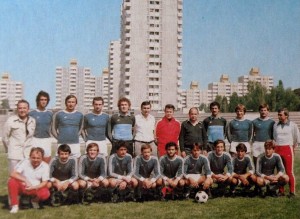
One more look at the boys from Nis.

Hajduk (Split) finished one point better than Radnicki – what is there to say? Running strong, constantly developing new talent, maintaining strong team – and constantly selling stars abroad. Hajduk had an excellent team, with eager young reserves ready to make their names as soon as possible. Second place was perhaps a bit of disappointment, but it was just not their year.
If not Hajduk, then Crvena zvezda… 15 wins, 14 ties, 5 losses, the best attack – 62 goals scored, the second-best defense, and 16th title. Two points ahead of Hajduk at the end.
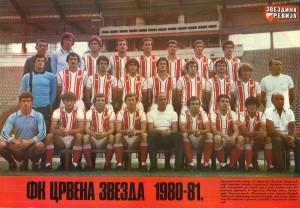
Sitting, from left: M. Durovski, M. Sestic, Vl. Petrovic, B. Stankovic – coach, R. Janjanin, S. Stamenkovic, C. Blagojevic, dr. B. Babic – team doctor.
Middle row: D. Simeunovic, Z. Borovnica, I. Jurisic, B. Durovski, S. Repcic, M. Jovin, Z. Krmpotic, N. Milosavljevic, G. Zivanovic, Kostic – assistant coach.
Third row: Kotlajic – physio, Z. Ljukovcan, Bingulac (?), D. Miletovic, M. Rajkovic, Z. Jelikic, Lj. Stojanovic, M. Jankovic.
A few minor changes occurred during the season, but the the starting eleven was quite impressive:
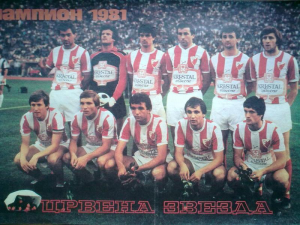
Standing: Dragan Miletovic,Dragan Simeunovic,Ivan Jurisic,Slavoljub Muslin,Zlatko Krmpotic,Milan Jovin.
First row:Vladimir Petrovic,Milos Sestic,Radomir Savic,Rajko Janjanin,Srebrenko Repcic.
Full of national team players – and also future once, like Dragan Simeunovic – and a squad wit hreal depth – Simeunovic was not real regular, but shared with equally talented Ljukovcan, for instance. However, this was not as famous team as the one of the early 1970s, which gave half of the Yugoslavian squad at the 1974 World Cup. The big star was Vladimir Petrovic, the only remaining link with the old great team, led by Dragan Dzajic. May be the difference made this title rather routine in the eyes of fans and observers, but it counts and it was not an easy one.
 Third row: Paul Kilgus (Teambetreuer), Urs Egli, Rafael Chèlos – Walter Christinger, Christian Häni, Armin Döbeli, Paul Hollenstein (Physiotherapeut).
Third row: Paul Kilgus (Teambetreuer), Urs Egli, Rafael Chèlos – Walter Christinger, Christian Häni, Armin Döbeli, Paul Hollenstein (Physiotherapeut).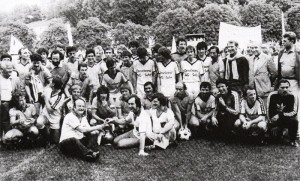 With 35 points – one more than FC Bulle – FC Aarau took the 2nd place. Just enough for promotion and although the season was not great, Aarau not only returned to the finest, but was the only promoted team with a good chance to establish itself in the to top league.
With 35 points – one more than FC Bulle – FC Aarau took the 2nd place. Just enough for promotion and although the season was not great, Aarau not only returned to the finest, but was the only promoted team with a good chance to establish itself in the to top league.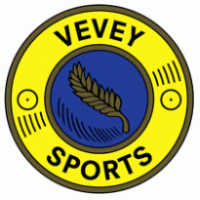 Vevey-Sports won the Second Division – a big success for the small club. It was not an overwhelming victory – they clinched the title by a single point – but nevertheless it was great for a club not known for winning. And better days loomed ahead, at least temporary – going to first division was division was wonderful, surviving there was a problem.
Vevey-Sports won the Second Division – a big success for the small club. It was not an overwhelming victory – they clinched the title by a single point – but nevertheless it was great for a club not known for winning. And better days loomed ahead, at least temporary – going to first division was division was wonderful, surviving there was a problem.